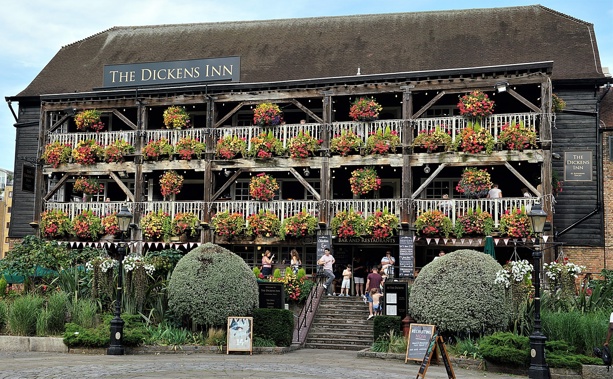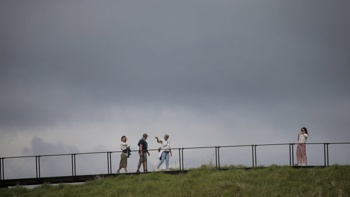
One of the most thirst-quenching ways to soak up London’s rich history is over a pint or two in the pubs. Warm ales, warm rooms and warm company. London’s pub-gathering tradition hasn’t dimmed – they continue to do it so well. In a city awash in watering holes, London’s most time-honoured pubs reach back over five hundred years, riddled with stories, famous clientele, all-out drama, scandal and even murder. When I lived in London 20 years ago, I discovered many of these storied boozers on a city stroll with London Walks, who still do a very fine job leading guided walks, spilling the city’s secrets and sharing the hidden gems down brooding back-alleys.
Every English pub, like these old-timers, strives to be a place of solace and delight. But what makes the enclosed assortment of historic pubs all the more compelling is their back-story, stomping grounds for hangings and hauntings, epic moments in history, devastating tragedy and even mass-murder. But whether you choose to take a guided walk or prefer to roam on your own, here’s some great inns to keep in mind.
Near the British Museum, Ye Olde Mitre Tavern in Holborn is one of London’s greatest veterans, a long-living local since the Elizabethan age. This low-ceilinged inn, built in 1546, backs on to a courtyard in which Queen Elizabeth I would regularly dance in. Originally licensed to the Bishop of Ely, it used to be guarded by his frock-coated officials. You can still see the blackened stump of the courtyard maypole that HM frolicked around. A dedicated room for smoking, known as a snug, was added in the 1700s. Few authentic snugs remain, but Ye Old Mitre has preserved there one, called the Closet, with intimate seating for six. The pub decor looks frozen in time - Tudor beams, coal fires, portraits of Henry VIII and dozens of whisky water jugs hanging from the ceiling.
A recurring theme within many of London’s most venerable boozers is how they resonated with the city’s most acclaimed writers of the day. Ye Olde Cheshire Cheese in Fleet Street is a prime specimen. Very old, but not at all cheesy. The scroll at the door lists the 15 monarchs who have reigned since it first opened in 1667. This warren of low-slung oak-panelled rooms still has sawdust strewn on its floors, making it easier to mop up the beer slops. Samuel Johnson was one of its first famous patrons, and in the 19th century, it was a regular hang-pad for Yeats, Dickens and Oscar Wilde. Its cherished antiquity is unmistakable.
Another literary landmark would have to be the Spaniards Inn. in Hampstead Heath. Dating back to 1585, it was actually immortalised in Dickens’ “The Pickwick Papers”, while Keats penned “Ode to a Nightingale” in the garden. It even gets a shout-out in Bram Stoker’s “Dracula.” Located down a dark alley, it still reeks of clandestine meetings or running into highwaymen in black coats. Dick Turpin was born here and apparently learnt his criminal ways in the pub.
Bar staff at the Spaniards Inn have routinely claimed of seeing apparitions of Dick Turpin, over the years. Then again, I’d prefer that to Dracula. The ghost stories spill forth from that pub, as they do at The Ten Bells, a sinister-looking old boozer in Spitalfields. Every Jack the Ripper tour in London weaves this pub into its schtick. The faded décor and candlelight sets the stage for a caseload of haunted stories. This shabby old pub was a regular haunt for the Victorian prostitutes who all fell victim to the Ripper.
I do love The Dove in Hammersmith, a 400-year-old classic reached down a cobbled alley. The composer of Rule Britannia lived on the upper floor, while Graham Greene, Ernest Hemingway and Richard Burton and Dylan Thomas were all notorious drinkers who once sat on the bar stools. The Dove is one of the best pubs in London to view the annual Oxford vs Cambridge Boat Race, with a fabulous terrace above the Thames.
Also riverside, the Prospect of Whitby at Wapping sits alongside the old Execution Dock – where many a pirate met his end. Beginning life in 1543 as the Devil’s Tavern, the flag-stoned interior brims with nautical artefacts like rum barrels and ship wheels. Real masts are built into the structure surrounding the pewter-topped bar. On the balcony, a creepy noose swings in the breeze to commemorate George Jeffreys, "The Hanging Judge", who would drink here after a day's work at the Execution Dock.
Further up the river in Rotherhithe, the riverside pub, The Mayflower, was so named because it’s right next to the original mooring point of the ship that set off to Southampton, before setting sail to the New World packed with pilgrims. First built in 1550, it was previously called The Spread Eagle before changing its name in honour of the ship. It’s stunningly atmospheric tavern, although the taxidermy trimmings are an acquired taste – like the stuffed rats in cages.
If you find yourself in elegant Belgravia, stake out The Star Tavern, which was a beacon of the swinging ‘60s. The grand upstairs room was supposedly where the Great Train Robbers hatched their plan to attack the Mail service in 1963. Bruce Reynolds, the ringleader, would reportedly rock up in an Aston Martin to flesh out the details of the multi-million dollar heist.
The pleasure pit of Soho is home to The French House, which actually played a pivotal role in World War II. The pub was used as a meeting place for members of the French Resistance, including General de Gaulle. Beer is still, famously, served only in halves, and it’s a stickler for enforcing its mobile-phone ban.
If there was just one historic pub I’d urge you to not too miss, The George Inn by London Bridge would be it. William Shakespeare propped up the bar here and his plays were performed in the courtyard to the balconies of eager patrons, who lapped it up. That courtyard previously was the site of The Tabard Inn, where Chaucer set the beginning of ‘The Canterbury Tales.’ Oh the history – suck it up.
Mike Yardley is our Travel Correspondent on Jack Tame Saturday Mornings.
Take your Radio, Podcasts and Music with you









